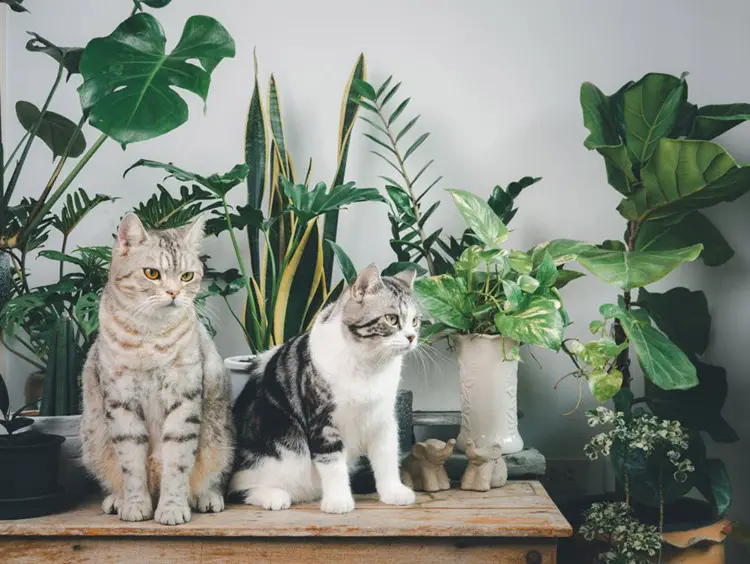Hello there, cat lovers! Are you on the lookout for the perfect houseplant that won’t harm your beloved feline? Look no further! We have put together a comprehensive list of the best houseplants for cats that are not only safe but also visually appealing.
We understand that as cat owners, we want the best for our furry friends while still maintaining a stylish and comfortable home. With these 20 houseplants, you can have both! We’ve done the research and gathered all the information you need, so you don’t have to spend hours scouring the internet for safe and cat-friendly options.
From low-maintenance choices to vibrant and colorful options, we’ve got you covered. So, kick back, relax, and let us guide you through the best houseplants for cats!
Key Takeaways:
- We have compiled a list of the 20 best houseplants for cats that are safe and visually appealing.
- As cat owners, we understand the importance of providing a cat-friendly environment without compromising on style.
- Our list includes low-maintenance choices, vibrant and colorful options, and tips on how to care for them.

Understanding the Importance of Cat-Friendly Houseplants
As cat lovers and plant enthusiasts, we understand the appeal of bringing the natural beauty of the outdoors into our homes. However, it’s crucial to choose indoor plants that are safe for our furry friends. Many common houseplants can be toxic to cats if ingested, causing a range of symptoms from mild irritation to severe illness or even death. This is why it’s essential to prioritize the safety of our pets when selecting indoor plants.
Creating a cat-friendly environment that includes safe and attractive indoor plants provides numerous benefits for both cats and humans. Non-toxic houseplants can provide mental stimulation and a sense of calm for cats, contributing to their overall well-being. At the same time, these plants can enhance our home’s aesthetic appeal, creating a relaxing and visually pleasing environment.
To select safe houseplants for our feline friends, we need to understand their behavior and preferences. Cats tend to be curious creatures, and they can be attracted to plants with interesting textures and smells. They also enjoy climbing, hiding, and exploring, making it essential to consider the size and structure of indoor plants. By taking these factors into account, we can choose indoor plants that are both safe and appealing to cats.
Factors to Consider When Choosing Cat-Safe Houseplants
When selecting houseplants for your home, it’s important to consider your furry feline friend’s safety and well-being. Here are some factors to keep in mind when choosing cat-safe houseplants:
- Plant toxicity: Some plants can be toxic to cats if ingested. Check the ASPCA’s list of toxic and non-toxic plants to ensure your selection is safe for your cat.
- Leaf structure: Cats are naturally curious and may be drawn to plants with dangling or wiggling leaves that are easy to swat. Avoid plants that have thin or delicate leaves, as they may be easily damaged by curious claws.
- Growth habits: Consider the growth habits of your chosen plant, as some cats may enjoy nibbling on new growth or digging in the soil. Look for plants that are resilient and able to withstand some light damage.
When it comes to choosing cat-safe houseplants, it’s also important to keep your feline’s behavior and preferences in mind. Some cats may be more adventurous than others, so be sure to choose plants that can accommodate their natural habits and movements. With these factors in mind, you can create a safe and harmonious indoor environment for both you and your feline friend.
10 Safe and Attractive Houseplants for Cats: Low-Maintenance Options
As cat owners, we understand the importance of selecting houseplants that are safe and attractive for our feline friends. Here are ten low-maintenance options that are non-toxic and easy to care for:
- Spider Plant: This plant is a favorite among cat owners for its air-purifying qualities and non-toxicity. It can thrive in most indoor environments and requires minimal watering.
- Ponytail Palm: The unique appearance of this plant makes it an attractive addition to any indoor space. It requires infrequent watering and can tolerate low-light conditions.
- Boston Fern: This lush, leafy plant is non-toxic and can help improve air quality. It requires frequent watering and bright, indirect light.
- Calathea: The vibrant, patterned leaves of this plant can add color and interest to any room. It requires moderate watering and indirect light.
- Cast Iron Plant: As the name suggests, this plant is extremely hardy and can tolerate low-light conditions. It requires infrequent watering and is non-toxic to cats.
- Croton: This plant has brightly colored leaves that can complement any decor. It requires bright, indirect light and frequent watering.
- Parlor Palm: The compact size of this plant makes it ideal for small indoor spaces. It requires infrequent watering and can tolerate low-light conditions.
- Rattlesnake Plant: This plant has unique, patterned foliage that can add visual interest to your home. It requires moderate watering and indirect light.
- Staghorn Fern: This plant can be mounted on a wall or displayed in a hanging basket. It requires bright, indirect light and frequent watering.
- Zebra Plant: The distinctive striped leaves of this plant make it a striking addition to any indoor space. It requires moderate watering and indirect light.
These safe and attractive houseplants for cats are easy to care for and can enhance the beauty of any indoor space. By choosing non-toxic and cat-friendly plants, we can ensure the well-being of our feline companions and enjoy the benefits of indoor gardening.

10 Safe and Attractive Houseplants for Cats: Vibrant and Colorful Choices
In addition to the low-maintenance plants we listed earlier, there are plenty of colorful and vibrant options that are also safe for your feline friend.
Fun fact: Bromeliads are named after Olof Bromelius, a Swedish botanist.
- Bromeliads: These striking tropical plants come in a range of colors and are safe for cats. They enjoy bright, indirect light and require minimal watering.
- Polka Dot Plant: This whimsical plant comes in a variety of hues, ranging from green to pink and white. They do best in bright, indirect light and require consistent watering.
- Spider Plant: This classic indoor plant is safe for cats and has an attractive cascading growth habit. They prefer bright, indirect light and well-draining soil.
- African Violet: These lovely and delicate plants come in various shades of purple and pink. They prefer bright, indirect light and consistent moisture.
- Peperomia: This versatile plant is available in a variety of colors and textures, making it perfect for adding visual interest. They prefer indirect light and moderate watering.
- Calathea: These plants have stunning foliage patterns and come in various colors. They prefer low to medium light and require consistent watering.
- Rattlesnake Plant: This unique plant has elongated leaves with striking patterns. They prefer low to medium light and consistent watering.
- Christmas Cactus: This festive plant blooms in shades of pink, red, and white, adding color to your home during the holidays. They prefer bright, indirect light and require minimal watering.
- Friendship Plant: This charming plant has rounded leaves with distinct patterns. They prefer low to medium light and consistent watering.
- Moth Orchid: These elegant flowering plants come in a variety of colors and are safe for cats. They prefer bright, indirect light and require moderate watering.
Keep in mind that while these plants are safe for cats, they may still cause an upset stomach if ingested in large quantities. As with all houseplants, monitor your cat’s behavior around them and seek veterinary attention if you notice any unusual symptoms.
Creating a Cat-Friendly Environment with Houseplants
When it comes to having indoor plants with cats, it’s essential to create a cat-friendly environment to keep both your furry friend and your plants healthy and happy. Not only do indoor plants add aesthetic value to your home, but they also provide mental stimulation and a sense of calm for your cats.
When it comes to arranging plants, consider your cat’s natural climbing and hiding behaviors. Incorporate tall or hanging plants to create safe spaces for them to explore and rest. You can also use plant stands to keep plants off the floor, preventing your cats from knocking them over.
It’s important to choose plants that are non-toxic and safe for cats. But even safe plants can cause issues if they’re not adequately cared for. Overwatering, underwatering, and lack of sunlight can make plants less robust and more susceptible to pests and diseases.
To keep your plants and cats healthy, avoid using harsh chemicals like pesticides and fertilizers. Instead, opt for natural solutions like neem oil or diluted vinegar to keep pests at bay. If you’re unsure about a plant’s safety or care requirements, consult with a veterinarian or a horticulturist.
Common Cat-Safe Indoor Plant Care Mistakes to Avoid
As cat owners, we want to ensure that our furry friends are safe and happy. When it comes to indoor plants, it’s essential to choose cat-safe options, but it’s also crucial to avoid common care mistakes that can harm both the plants and the cats. Here are some common cat-safe indoor plant care mistakes to avoid:
- Overwatering: While plants need water to grow, overwatering can lead to root rot and other issues. Make sure to research the watering needs of your specific plants and avoid overwatering them.
- Improper drainage: Proper drainage is critical for the health of your plants. Make sure to use pots with drainage holes, and avoid letting water accumulate in the saucer beneath the pot.
- Placing plants in direct sunlight: While many indoor plants thrive in bright, indirect light, direct sunlight can scorch their leaves. Make sure to research the lighting needs of your plants and place them in appropriate locations.
- Using the wrong type of soil: Different plants require different types of soil to thrive. Make sure to research the soil needs of your plants and use appropriate potting mix.
- Not providing enough humidity: Many indoor plants require higher levels of humidity than what is naturally present in most homes. Consider using a humidifier or placing a tray of water near your plants to increase humidity.
- Using harmful pesticides: If you need to use pesticides to control plant pests, make sure to use cat-safe options. Avoid using pesticides that contain chemicals that can harm your cat.
By avoiding these common mistakes, you can ensure that your indoor plants thrive while also keeping your cats safe and healthy.
Dealing with Cats and Houseplant Chewing: Prevention and Management
It’s not uncommon for cats to show an interest in houseplants. Some may even resort to nibbling on leaves or flowers. While this behavior may seem harmless, it can actually be dangerous if the plants in question are toxic to felines. Here are some strategies to prevent and manage this behavior:
- Choose non-toxic houseplants: As we’ve discussed, selecting non-toxic houseplants is the first step in creating a cat-friendly environment. This reduces the risk of your feline friend ingesting harmful substances.
- Provide suitable alternatives: Cats are naturally curious creatures and enjoy exploring their surroundings. Providing suitable alternatives such as cat grass or catnip can help satisfy their natural chewing instincts.
- Use cat deterrents: If your cat is particularly curious or persistent in its chewing habits, using cat deterrents such as bitter sprays or motion-activated devices can discourage them from approaching your plants.
- Reposition your plants: Sometimes, simply repositioning your plants can make all the difference. Placing them in high areas or using hanging baskets can prevent cats from accessing them.
- Train your cat: Training your cat using positive reinforcement techniques can also help discourage undesirable behaviors such as chewing on houseplants. Rewarding them for good behavior and redirecting their attention when they approach your plants can be effective.
“Remember that punishing your cat for chewing on your houseplants is not an effective solution. Instead, focus on positive reinforcement and providing suitable alternatives.”
By adopting these strategies, you can create a safer and more comfortable environment for both your plants and your feline friends.
Common Signs of Plant Toxicity in Cats and What to Do
As responsible cat owners, it’s important to know the common signs of plant toxicity in cats. This knowledge can help you identify potential problems early and seek veterinary attention promptly, if necessary.
Some common symptoms of plant toxicity in cats include:
- Vomiting
- Diarrhea
- Drooling or excessive salivation
- Lethargy or weakness
- Difficulty breathing
- Irregular heartbeat
- Seizures or tremors
If you notice any of these symptoms in your cat, it’s essential to take immediate action. Contact your veterinarian or a pet poison control hotline for guidance on next steps.
Preventative measures can also go a long way in keeping your pet safe from plant toxicity. Here are a few tips to keep in mind:
- Do your research: Before bringing any new plant into your home, research its safety for cats. There are many resources available online, including the ASPCA’s list of toxic and non-toxic plants.
- Choose safe plants: Stick to cat-safe indoor plants that are non-toxic and won’t harm your feline friend if ingested.
- Place plants out of reach: Keep plants in areas that are out of reach of curious cats. Consider hanging them from the ceiling or placing them on high shelves.
- Supervise outdoor time: If your cat spends time outdoors, be mindful of the plants in your yard and nearby areas. Again, research is key to identifying potential hazards.
- Consider alternatives: If you’re concerned about your cat’s tendency to chew on plants, consider providing alternative options such as cat grass or catnip.
By taking these measures, you can help keep your cat safe and healthy while enjoying the benefits of indoor plants.
Alternatives for Cat Owners: Non-Traditional “Plants”
For cat owners looking for alternatives to traditional houseplants, there are many options that can provide similar benefits without the risk of toxicity or damage to home decor. Here are a few ideas to consider:
- Cat grass: Many cats enjoy nibbling on fresh grass, and growing cat grass indoors or outdoors can provide a safe and healthy option. Cat grass is easy to grow and can be purchased at most pet stores.
- Catnip: Catnip is a herb that cats find irresistible. Growing it indoors or outdoors can provide your cat with a source of stimulation and fun. Just be prepared for your cat to get a little wild!
- Bamboo: Lucky bamboo is a popular plant that is safe for cats. It adds a touch of zen to any room, and can be grown in water without soil.
- Aquariums: Setting up an aquarium can be a great way to provide entertainment for your cat. Watching fish swim can be relaxing and fun for cats, and there are many low-maintenance options available.
Remember, it’s important to supervise your cat’s interactions with any non-traditional “plants” to ensure their safety and avoid any potential hazards.
Safe Gardening Tips for Cat Owners: Outdoor Considerations
As much as we love our indoor feline friends, there’s no denying that cats are natural explorers. So, if you’re fortunate enough to have an outdoor space, it’s important to make sure it’s cat-friendly. Here are some tips on how to create a safe and enjoyable outdoor environment for your furry friend:
Choose Cat-Safe Plants
When it comes to gardening with cats, it’s important to choose plants that are non-toxic to felines. Some common toxic plants, such as lilies and azaleas, can cause severe illnesses or even death in cats. Instead, opt for cat-safe plants like catnip, cat thyme, and mint. Some other safe plant options for outdoor gardens include calendula, marigolds, and sunflowers.
Create Safe Spaces for Your Cat
Cats love to explore, but they also need a safe space to retreat to when they’re feeling overwhelmed or overstimulated. Consider creating a designated area in your outdoor space where your cat can relax and escape from the heat. This could be a cat tree, a shaded area, or a cozy nook with comfortable bedding.
Keep Pesticides and Chemicals Away from Your Cat
Many pesticides and chemicals commonly used in outdoor gardening can be toxic to cats when ingested or absorbed through their skin. Avoid using such products in areas where your cat has access, or consider using natural alternatives instead. You can also create a physical barrier around your garden to prevent your cat from getting too close to any potentially harmful chemicals.
Watch Out for Wild Animals
While cats are agile and quick, it’s important to be aware of potential threats from other animals in your outdoor space. This includes predators like coyotes, snakes, and birds of prey. Keep an eye on your cat when they’re outside, and consider creating a fenced-in area for added protection.
Conclusion
Outdoor gardening can be a fantastic way for cats to exercise, explore, and enjoy the fresh air. By following these tips and selecting the right plants, you can create a safe and enjoyable environment for your feline friend. Remember, the key to a happy and healthy cat is to always prioritize their well-being.
Conclusion: Finding the Perfect Houseplant for Your Feline Friend
We hope this article has provided you with valuable insights on selecting safe and attractive houseplants for your feline friend. By following our tips and recommendations, you can create a cat-friendly environment that enhances your cat’s well-being and your home’s aesthetic appeal.
Remember to consider your cat’s behavior, preferences, and safety when choosing indoor and outdoor plants. By avoiding toxic plants, providing suitable alternatives, and maintaining proper care, you can ensure a harmonious coexistence between your furry companion and your beloved plants.
Thank you for reading, and happy houseplant hunting!
Additional Resources and References
We hope that this article has been helpful in guiding you towards safe and attractive houseplants for your feline friend. If you’re looking for more information or resources on the topic, here are some additional references:
- The ASPCA’s List of Toxic and Non-Toxic Plants for Cats
- The Humane Society’s Guide to Pet-Safe Gardening
- The Cat Fanciers’ Association’s Recommendations for Cat-Safe Houseplants
- The Spruce Pets’ Guide to Cat-Friendly Houseplants
- The House Plant Journal’s Tips for a Pet-Friendly Plant Collection
Remember, when it comes to choosing houseplants for your cat, it’s important to prioritize their safety and well-being. By selecting cat-friendly plants and creating a suitable environment, you can maintain a happy and harmonious home for both you and your feline friend.
FAQ
Q: What are the best houseplants for cats?
A: We have compiled a list of the 20 best houseplants for cats that are both safe and attractive. These plants have been carefully selected to ensure they won’t harm your feline friend while adding beauty to your home.
Q: Why is it important to choose cat-friendly houseplants?
A: Cat-friendly houseplants are crucial to ensure the safety and well-being of your cat. Toxic plants can be harmful if ingested, and creating a cat-friendly environment helps prevent accidents and keeps your furry friend happy.
Q: What factors should I consider when choosing cat-safe houseplants?
A: When selecting cat-safe houseplants, factors such as plant toxicity, leaf structure, and growth habits should be taken into account. It’s important to choose plants that align with your cat’s behavior and preferences.
Q: Can you recommend some low-maintenance houseplants that are safe for cats?
A: Absolutely! We have compiled a list of 10 low-maintenance houseplants that are safe and attractive for cats. These plants thrive indoors and require minimal care, making them ideal choices for cat owners.
Q: Are there any vibrant and colorful houseplants that are safe for cats?
A: Yes! We have compiled a list of 10 vibrant and colorful houseplants that are safe for cats. These plants will not only add beauty to your indoor space but also provide a safe environment for your curious cat.
Q: How can I create a cat-friendly environment with houseplants?
A: Creating a cat-friendly environment with houseplants involves considering your cat’s natural climbing and hiding behaviors. We provide tips on arranging plants to accommodate these behaviors, ensuring a harmonious coexistence.
Q: What are some common mistakes to avoid when caring for indoor plants?
A: This section addresses common mistakes that cat owners make when caring for indoor plants. It offers tips on proper watering, fertilizing, and placement to ensure the well-being of both the plants and the cats.
Q: How can I prevent my cat from chewing on houseplants?
A: We offer strategies to prevent and manage cats chewing on houseplants. Providing suitable alternatives for cats to satisfy their chewing instincts is essential for maintaining the safety of both the cats and the plants.
Q: What are the common signs of plant toxicity in cats?
A: This section provides information on the common signs of plant toxicity in cats. It advises readers on what to look out for and emphasizes the importance of seeking immediate veterinary attention if necessary.
Q: Are there any alternatives for cat owners who prefer non-traditional “plants”?
A: Yes! We introduce alternative options for cat owners, such as cat grass and catnip, that can provide similar benefits as traditional houseplants. These alternatives contribute to a cat-friendly environment.
Q: What are some safe gardening tips for cat owners?
A: This section provides guidance on safe gardening practices for cat owners with outdoor spaces. It emphasizes the importance of selecting cat-safe plants, creating safe areas for cats, and addressing potential outdoor dangers.
Q: Can you provide additional resources and references on safe houseplants for cats?
A: Absolutely! We offer a list of additional resources and references for readers who want to explore the topic further. These include links to reputable websites, books, and other sources with valuable information.













Comments are closed.